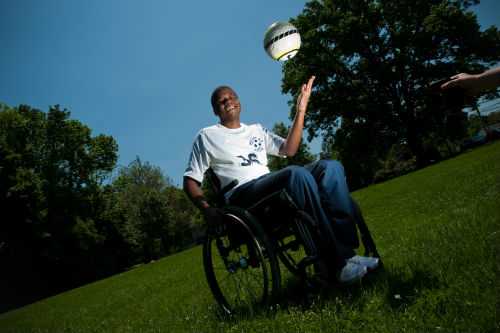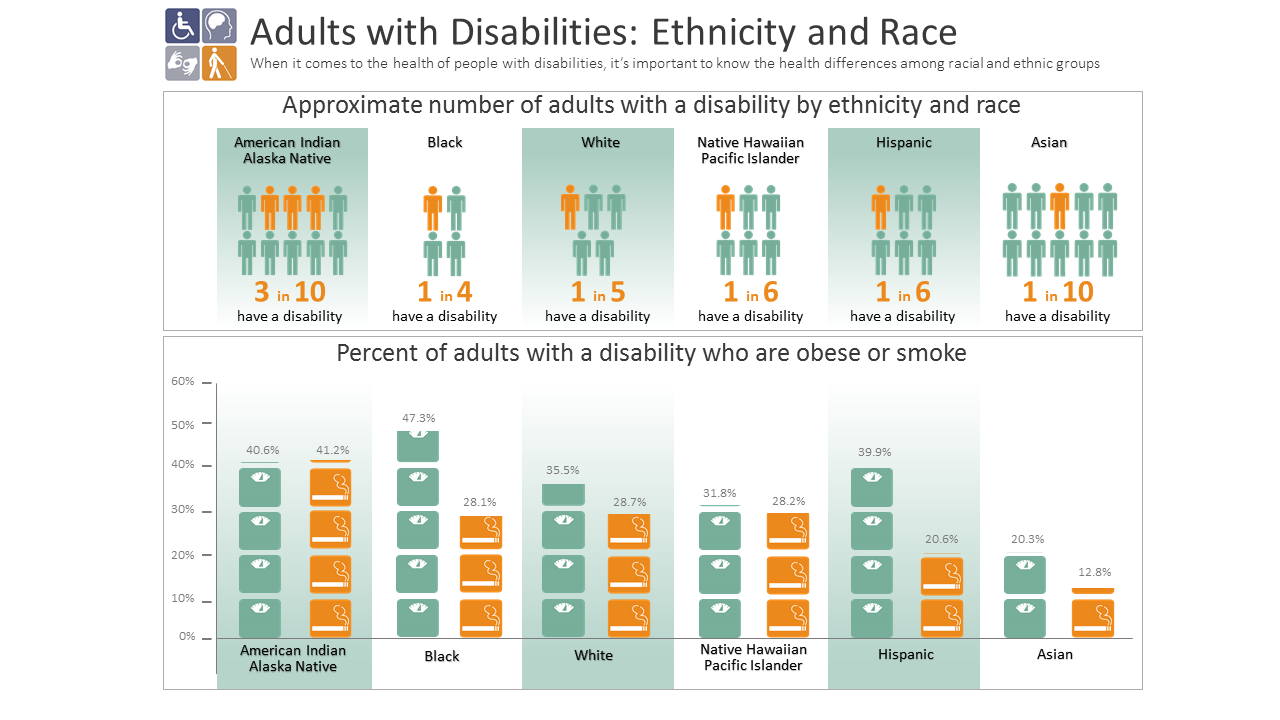Key Findings: Socioeconomic Factors at the Intersection of Race and Ethnicity Influencing Health Risks for People with Disabilities
Health risk behaviors among people with disabilities from racial and ethnic groups

The Journal of Racial and Ethnic Health Disparities has published a new study looking at the relationship between income and education, and two health behaviors—smoking and obesity—among people with disabilities from different racial and ethnic groups. To conduct this study, CDC researchers used information reported by respondents to the 2007-2010 Behavioral Risk Factor Surveillance System surveys. Researchers found that the proportion of adults living with disabilities varies by race and ethnicity, with the highest among American Indian/Alaska native adults (3 in 10) and lowest among Asian adults (1 in 10). Similar to people without disabilities, people with disabilities with low levels of income or education are more likely to smoke or be obese. However, according to this study, how income and education relate with smoking and obesity differs by race and ethnicity.
Everyone, including people with disabilities, needs health care and health programs to stay healthy and avoid unhealthy behaviors. Public health professionals can use the information in this article to highlight groups who may be more likely to report smoking and obesity, and to ensure that programs that promote good health are inclusive of people with disabilities.
Read a scientific summary of the article.
Main Findings
The infographic below shows the percentage of people with disabilities in each racial and ethnic group who report that they are obese or that they smoke.
- The findings in the paper further show that people with disabilities with the following characteristics are more likely to smoke:
- American Indian/Alaska naive,
- Less than high school education, or
- Annual income of less than $20,000
- It also shows that people with disabilities with the following characteristics are more likely to be obese:
- African Americans, or
- Less than college education

About This Study
- To conduct this study, CDC researchers used data from the 2007-2010 Behavioral Risk Factor Surveillance System. In this survey, respondents were asked if they have to use any special equipment or have activity limitations because of physical, mental, or emotional problems. Respondents who answered “yes” were considered to have a disability.
- Current smoking was defined as reporting having smoked at least 100 cigarettes in one’s lifetime and currently smoking every day or some days. Obesity was defined as a body mass index of 30 or greater, calculated from the height and weight reported by the respondent.
What Can Be Done?
Health promotion and disease prevention programs focusing on smoking and obesity that are inclusive, not only of people from diverse racial and ethnic groups, but also inclusive of people with disabilities may help. This can be done by
- Identifying health differences between people with and without disabilities from diverse racial and ethnic groups.
- Understanding the challenges people with disabilities from diverse racial and ethnic groups face in participating in health promotion and disease prevention programs and activities.
- Developing and implementing strategies for promoting health and preventing disease that are inclusive, encourage diversity, and address the specific needs of all participants.
CDC’s Activities
CDC’s Disability and Health Branch monitors the health of people with and without disabilities, and supports the inclusion of people with disabilities in public health programs that prevent disease and promote healthy behaviors. In addition, CDC works to eliminate barriers to health care and improve access to routine preventive services.
CDC supports 19 state-based disability and health programs and two National Public Health Practice and Resource Centers, which promote healthy lifestyles and work to improve quality of life for people with disabilities. The primary goals of the state programs are to
- Increase health promotion opportunities for people with disabilities, and
- Improve access to healthcare services for people with disabilities.
CDC also maintains Disability and Health Data System (DHDS), an online interactive tool that provides instant access to state-level, disability-specific health data. Users can customize the disability and health data they view, making it easy to identify health differences between adults with and without disabilities.
Additional Information
Find out more about CDC’s Disability and Health Branch at
https://www.cdc.gov/ncbddd/disabilityandhealth/index.html
References
Courtney-Long EA, Romano SD, Carroll DD, Fox MH. (2016) Socioeconomic Factors at the Intersection of Race and Ethnicity Influencing Health Risks for People with Disabilities. J Racial Ethn Health Disparities. Advance online publication.
- Page last reviewed: August 17, 2016
- Page last updated: August 17, 2016
- Content source:


 ShareCompartir
ShareCompartir